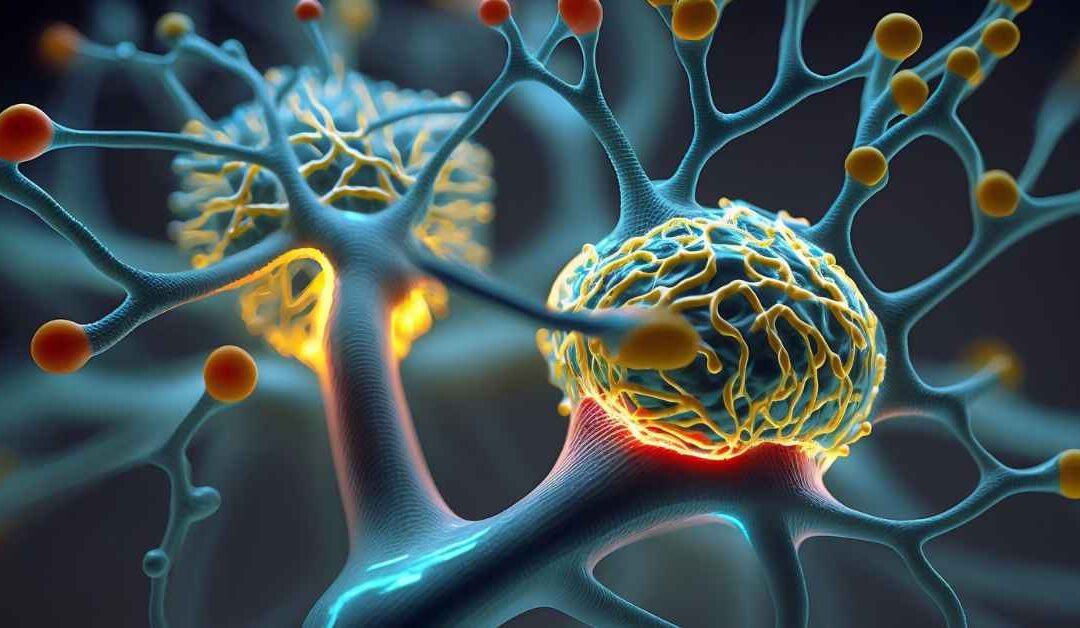Have you ever felt like your brain and body are at odds with each other? Do you find yourself overwhelmed, anxious, and out of control more often than not? If so, you may be experiencing nervous system dysregulation. Imbalances in this system can be the source of several physical and mental health issues. Many people are unaware that their nervous system plays such a crucial role in their well-being. As unfortunate as it is, nervous system dysregulation is more common than you might think, yet resources for addressing it are often scarce. We’re on a mission to change that by making this vital information more accessible, so please share it if you find it helpful.
This guide digs deep into the science behind the nervous system and offers several practical techniques you can start implementing today to nourish and recalibrate your nervous system. Step-by-step, through the application of these tools, you will find greater ease in your life. Let’s begin with the fundamentals.
What Is Nervous System Dysregulation?
Nervous System Dysregulation occurs when your nervous system remains in a perpetual state of survival mode, signaling danger throughout your body even when there is no immediate threat to your life. This extended state of high alert causes unpleasant experiences such as anxiety, under- or over-reacting in any given situation, feeling scared, feeling unsafe in your body, panic attacks, overwhelm, depression, and feeling numb, disconnected, and dissociative. Essentially, the synergy between your brain and body becomes disrupted, impacting every aspect of your life.
If you are struggling with any of these issues, you are not alone. Living with a dysregulated nervous system can be challenging and exhausting. When our nervous system is out of balance, we may find ourselves reacting excessively to everyday situations, either by overreacting or by withdrawing and becoming disconnected from life. This can get in the way of participating meaningfully in the world around us and living life to the fullest. When something as small as a misplaced item or an advertisement on television triggers extreme emotions of anger, sadness, etc. making daily life feel like an uphill battle.
Over time, the body becomes accustomed to this state of heightened alertness, making it challenging to naturally return to a state of equilibrium, or homeostasis, on its own. Thankfully, with dedication, you can re-regulate your nervous system, become free from the grip of fear, and return to a consistently peaceful state.
But what leads to this dysregulation in the first place? What triggers the nervous system to malfunction, and is it feasible to restore it to a state of balance? These are essential questions we’ll explore in the following sections.
What Causes Nervous System Dysregulation?
Nervous system dysregulation can be caused by a single traumatic event, like a car accident or an abusive relationship, or prolonged exposure to stress in a toxic environment.
During periods of intense stress or enduring trauma, our bodies often remain in a constant state of “fight or flight.” As this perpetuates, the effects become more and more negative. The brain perceives that we are in danger, and the sympathetic nervous system kicks into gear to help us deal with the threat. This response is a critical evolutionary mechanism honed over millions of years to help humans survive in challenging environments. However, in contemporary life, even minor triggers can activate a dysregulated nervous system, prompting it to enter a protective mode.
Traumatic events that can lead to nervous system dysregulation include car accidents, natural disasters, physical abuse, sexual abuse, military combat, etc. However, the impact of such events is not solely determined by the event itself but rather by our perception and coping mechanisms. According to the Greek Stoic philosopher Epictetus, it is not the events themselves that disturb us but rather our perspective or interpretation of them. It is the story we tell ourselves about the event that has a lasting impact, whether positive or negative.
For example, someone who experienced a car accident may have been able to process the event and move on with their life without any long-term effects. But someone who was in the same car accident and blames themselves for what happened may struggle with anxiety, depression, and survivor’s guilt long after the event has passed. This illustrates how even a singular event can lead to nervous system dysregulation if perceived as sufficiently intense.
Exposure to toxins, whether physical (e.g., heavy metals, pesticides) or emotional (e.g., verbal abuse, manipulation), can also contribute to nervous system dysregulation. Toxins can infiltrate our bodies through various avenues, including the food we consume, the water we drink, the air we breathe, and the products we use.
The first step to healing a dysregulated nervous system is to understand how the stress response works. Let’s start with the basics.
How Does Nervous System Dysregulation Happen? According to Science
When faced with a potential threat, the body’s stress response system kicks into action, releasing hormones that prepare us to fight or flee. This automatic reaction, orchestrated by the amygdala and hypothalamus, triggers changes in heart rate, blood pressure, and breathing, all in a split second to safeguard our survival.
However, this stress response is meant to be temporary. Chronic activation of survival mode can lead to nervous system dysregulation. When we are repeatedly subjected to stressful situations and lack the coping skills to deal with that stress, the nervous system approaches dysregulation.
When a stressful event is experienced, the amygdala, a part of the brain that facilitates the processing of emotion, sends a signal of distress to the hypothalamus. The hypothalamus acts as a sort of command center for the autonomic nervous system, the part of the nervous system that controls involuntary processes like heart rate and digestion. In response to the amygdala’s signal, the hypothalamus sends out its own set of orders via the sympathetic nervous system to the pituitary gland, which awakens the adrenal glands. The adrenal glands then release adrenaline through the bloodstream. This triggers the fight-or-flight-or-freeze response. This all occurs before our brains can even visually grasp what is happening.
Over time, this chronic activation of the stress response system can have detrimental effects on our health, contributing to conditions such as high blood pressure, anxiety, depression, and insomnia. Recognizing the impact of chronic stress on the nervous system is crucial for implementing strategies to restore balance and promote overall well-being.
Autonomic Nervous System: Balancing Two Opposites
The parasympathetic and sympathetic nervous systems work in tandem, each performing its tasks while exerting opposite effects. For example, one stimulates the heart rate, while the other causes a decrease in heart rate.
In a healthy nervous system, these two systems maintain a harmonious balance, adjusting to environmental cues seamlessly. The parasympathetic system reigns during periods of safety, keeping the sympathetic system in check. However, in times of real danger, the parasympathetic system steps back, allowing the sympathetic system to take charge and respond appropriately.
The nervous system is considered dysregulated when there is an imbalance between the sympathetic and parasympathetic nervous systems. The autonomic nervous system can no longer automatically determine which system needs to be active at any given time. Instead, it will chronically over-activate the sympathetic nervous system, causing strong emotions (such as fear, anger, and sadness) and physical complaints (such as high blood pressure or migraine headaches).
Chronic Stress Response
Your sympathetic nervous system is like a security guard, constantly on the lookout for danger. When it perceives a threat, it activates your fight-or-flight response, releasing stress hormones like adrenaline and cortisol. While these hormones assist in dealing with the threat, they also induce unpleasant sensations such as a racing heart and jitteriness. Typically, once the threat dissipates, the sympathetic nervous system returns to its baseline state. However, chronic stress can cause it to remain persistently activated.
The sympathetic nervous system is not designed for prolonged activation; it’s meant to be for brief bursts in response to immediate threats. Unfortunately, in our modern world, we are exposed to more chronic stressors (such as work deadlines, financial worries, and family conflict) that can keep our sympathetic nervous system turned on for too long. This can lead to problems such as anxiety, insomnia, and difficulty concentrating.
Fortunately, there are strategies to disrupt this cycle of chronic stress. Regular exercise, relaxation techniques, and spending time in nature are effective ways to activate the parasympathetic nervous system, promoting a sense of calm. By reducing exposure to chronic stressors and prioritizing self-care in our daily lives, we can prevent the sympathetic system from becoming ensnared in a chronic stress response.
What Are the Symptoms of Nervous System Dysregulation?
The nervous system is a highly sensitive master control system of the body. It regulates and coordinates all the body’s activities.
When it malfunctions, it can disrupt every aspect of our lives.
A dysregulated nervous system will often cause us to respond inappropriately—disproportionally, that is, to what life throws at us. Our nervous systems have gotten good at protecting us from danger. When the nervous system is imbalanced, they can become hyper-vigilant and perceive harmless situations as dangerous. This heightened sensitivity can give rise to anxiety disorders.
This is where anxiety disorders develop. You know your nervous system is dysregulated when you start responding to life that doesn’t align with present reality but is instead influenced by past experiences. Indicating a disconnection between perception and reality.
This may be expressed both in the body and in our mental processes. Nervous system dysregulation can cause a wide range of physical, mental, and emotional symptoms. These symptoms can vary from person to person and can also change over time, but here are some of the most common:
-
- Anxiety
- Depression
- Chronic stress
- Irritability
- Mood swings
- Fatigue
- Insomnia
- Headaches
- Digestive issues
- Muscle pain
- Weight gain or loss
- Memory problems
- Difficulty concentrating
- PMS or other hormone imbalances
Trauma & the Nervous System
The relentless stress experienced throughout one’s life, whether during formative years or adulthood, can disrupt the efficient functioning of the nervous system. Consequently, even with access to effective tools, their utility may be limited if the nervous system remains dysregulated. Restoring equilibrium in our minds and bodies requires addressing the root causes of our stress, particularly trauma.
Trauma can have a profound effect on our nervous systems and if left unaddressed, it can leave us feeling stuck in cycles of chronic stress. Accumulated stress responses from past experiences render individuals either ‘hyper-responsive’ (hypersensitive) or ‘hypo-responsive’ (defensive, shut down). Caught in this pendulum swing between overreaction and withdrawal, unresolved stress responses manifest within the body, giving rise to various issues.
Power of the Mind-Body Connection: Regulating the Nervous System
There is hope. With the help of both modern and ancient techniques, you can rewire your brain and regulate your nervous system. By employing various methods that down-regulate the sympathetic nervous system and up-regulate the parasympathetic system, we can retrain our nervous system to respond differently to potential threats.
Interestingly, research indicates that even just thinking about the parasympathetic nervous system can help reduce stress levels. So even the most basic visualization of activating calm in your body is bringing your nervous system further towards balance. Establishing a healthy pattern and diligently working towards embodying it is crucial for creating lasting positive changes.
What Is a Regulated Nervous System?
So what’s it like to have a regulated nervous system? Some of us have lived for so long with an inconsistent or dysregulated nervous system that we have completely forgotten how it feels to experience safety. It is important to have a model of what a healthy nervous system looks like so we can pause and consciously mimic its reactions as we work to build new patterns.
A healthy nervous system operates with flexibility, allowing you to navigate through life’s experiences smoothly. When your body is in balance, you feel relaxed and connected to yourself. You can interact with the world with ease, feeling calm when necessary and being able to tap into emotion when appropriate. You can think clearly, make decisions based on facts instead of fear, and be present in each moment without feeling overwhelmed or anxious. A regulated nervous system empowers you to be responsive in your life, rather than reactive or numb. Learning and decision-making can become easier when they are not influenced by fear or perceived danger. You are fully present in each moment without feeling overwhelmed or anxious. Overall, having a regulated nervous system allows you to live with a sense of ease, confidence, and authenticity.
Situation A
Someone has a different opinion about something than you do.
Responses from a dysregulated nervous system: anxiety, fear, and feelings of aggression.
Response from a regulated nervous system: openness to hearing the other person’s perspective, curiosity, and willingness to learn.
Situation B
Your partner says that you guys need to have a talk.
Response from the dysregulated nervous system: You become overwhelmed with fear. Your heart rate increases, and you begin to worry intensely? Did they decide they didn’t love you anymore? Are they breaking up with you?
Response from a regulated nervous system: You feel concerned but remain calm. You can logically consider the different possibilities and choose how to proceed. You feel butterflies, but your overall response is one of curiosity. You can sense the tension, but you remain curious and open. You don’t jump to negative conclusions because you trust yourself to handle whatever comes up.
Situation C
Your friend is late for dinner.
Response from the dysregulated nervous system: You become angry and defensive. You think that they have forgotten about the plans. Your heart rate increases, and you feel disappointed that your friend isn’t respecting you or your time. How could they do this to you?
Response from a regulated nervous system: You may feel a twinge of disappointment, but you don’t become overwhelmed. Instead, you take a few deep breaths and decide to use this extra time to do something enjoyable, like read your favorite book or call a friend, instead of taking things personally. You know that things come up and people are busy, so you give them the benefit of the doubt.
It is possible to retrain your nervous system and begin to experience this type of regulated behavior in situations that previously had you feeling overwhelmed and anxious. Through mindful practice, breathing techniques, and emotional regulation skills, we can learn to reset our nervous systems and look at the world from a place of safety rather than fear. With conscious effort, these techniques can help us create new patterns so that dysregulation will no longer be the norm.
If this sounds like a far-off dream for you, don’t worry, you are in the right place. Often, we have to retrain our nervous system to feel safe.
Nervous System Regulation Exercise
It takes time to create new pathways and patterns. As you heal your nervous system, having tools that you can use in the moment of a reactive episode can be invaluable in preventing the spiral of suffering from taking hold.
Breaking the cycle of negative and fear-based thinking that stems from a dysregulated nervous system can be incredibly challenging. However, with dedication and conscious intervention, you have the power to choose how you respond to triggers, rather than simply reacting to them. This action is compounding and, with enough dedication, will eventually become your default. Here’s a simple exercise to help you maintain your composure when your nervous system starts to spiral:
Pause
Take a moment to pause and create space between the triggering event and your response. This step allows you to interrupt the automatic reaction and choose a more intentional response. You can pause by:
- Taking a deep breath and exhaling slowly.
- Counting to 10 or taking a short break to gather your thoughts.
- Stepping away from the situation temporarily, if possible, to give yourself time to process.
Example: “I notice that I’m feeling overwhelmed right now. I’m going to take a pause and give myself a moment to gather my thoughts before responding.“
Breathe
Focus on your breath to help calm your nervous system and bring your attention back to the present moment. Deep, slow breaths can help activate the relaxation response. You can try:
- Taking slow, deep breaths in through your nose and exhaling through your mouth.
- Paying attention to the sensation of your breath entering and leaving your body.
- Using a breathing technique, such as diaphragmatic breathing or box breathing, to regulate your breath.
Example: “I’m going to take a few deep breaths to center myself and calm my nervous system. Inhaling deeply and exhaling slowly.“
Bring Awareness
Bring your attention to the present moment and observe your thoughts, emotions, and bodily sensations without judgment. This practice of mindfulness helps create a sense of detachment from intense emotions and brings clarity to the situation. You can:
- Notice and acknowledge what you’re experiencing internally without trying to change it.
- Label your emotions or thoughts as they arise, such as “I’m feeling anxious” or “I’m having negative thoughts.”
- Observe any physical sensations in your body, like tension or tightness, and allow them to be present without resistance.
Example: “I’m bringing awareness to my thoughts and emotions without judgment. I notice that I’m feeling frustrated, and there’s tension in my shoulders.“
Ground Yourself
Grounding techniques help you connect with the present moment and your surroundings. They provide a sense of stability and safety, reducing feelings of anxiety or dissociation. Try:
- Feeling your feet firmly planted on the ground and becoming aware of the support beneath you.
- Engaging your senses by noticing the sights, sounds, smells, tastes, or textures around you.
- Practicing physical grounding exercises like squeezing a stress ball, touching a textured object, or splashing cold water on your face.
Example: “I’m grounding myself by feeling the floor beneath my feet and noticing the sound of the birds outside. This helps me feel more present and centered.“
Support Yourself
Provide yourself with self-compassion, understanding, and encouragement during difficult experiences. Use supportive and nurturing language to counteract negative self-talk. You can:
- Speak to yourself kindly and reassuringly, using phrases like “I’m doing the best I can” or “It’s okay to feel this way.”
- Offer yourself words of encouragement or affirmation, such as “I have overcome challenges before, and I can do it again” or “I am resilient and strong.”
- Practice self-care activities that bring you comfort and relaxation, like taking a warm bath, listening to calming music, or engaging in a hobby you enjoy.
Example: “I’m going to support myself by practicing self-compassion. It’s normal to feel overwhelmed, and I’m doing my best in this situation. I’ll take some time for self-care later to recharge.“
Remember, these steps and examples are just suggestions, and it’s important to find what works best for you.
Nervous System Regulation Techniques
Here are some of the most helpful tools for building new pathways and calming your nervous system:
Breathwork
The practice of consciously focusing on your breath and deliberately changing the pattern or intensity of your breaths. This helps to slow down the sympathetic nervous system and activate the parasympathetic system, bringing calmness to the body. Deep abdominal breathing can be particularly effective at calming a dysregulated nervous system as it directs oxygen toward our internal organs and helps relax the muscles of the body.
Affirmations
Positive statements that we repeat to ourselves to change our mindset and beliefs. When we focus on negative thoughts, we activate the stress response and further dysregulate the nervous system. Affirmations help us to focus on more positive and supportive thoughts, which eventually become ingrained in our belief system. This helps to create a sense of safety and security, reducing the flight-or-fight response.
Grounding Exercises
Help bring us back into the present moment. When we become dysregulated, our thoughts often take us away from the here and now as we think about past events or future possibilities. Grounding exercises help us to stay in the present moment and can include activities such as looking around the room, noticing objects in your environment, or focusing on the sensations of your body.
Mindfulness-Based Practices
A practice centered around focusing on the present moment without judgment or attachment. It encourages self-acceptance, non-judgmental awareness, and open observation of our internal experience. Mindfulness practices are incredibly effective at resetting the nervous system and can help us gain insight into our emotions, recognize patterns of thinking or behavior, and increase our capacity for self-compassion.
Yoga
A practice that combines physical movement with conscious breathwork and mindfulness. It is particularly effective at helping to regulate the nervous system and improve the overall balance of our mind and body.
Meditation
Another practice that is incredibly beneficial for calming a dysregulated nervous system,is that it helps us to create inner stillness and reduce stress levels.
Cold Therapy
Exposing our bodies to cold temperatures helps regulate the nervous system. For example, immersing ourselves in colder temperatures for short periods can help stimulate our sympathetic nervous systems and activate the ‘rest and digest’ response of our parasympathetic system.
Progressive Muscle Relaxation
A type of body-scanning technique that involves sequentially tensing and then releasing different muscle groups in the body. This practice helps to bring awareness and balance to our bodies, as it encourages us to pay attention to the sensations within each area of our body and understand how we are responding to stress.
Guided Imagery / Visualization
A practice where we use our imagination to focus on positive images, sounds, or sensations. It helps us to connect with the physical and emotional states that are associated with relaxation, which can help reduce tension in the body and bring balance back to our nervous system.
Journaling
Writing things down can be incredibly helpful in understanding and addressing our emotions. Journaling is a practice where we express our thoughts, feelings, and experiences through writing. It allows us to gain insight into our experience and can help us make sense of what’s going on emotionally or mentally. Additionally, it allows us to reflect on our thoughts and feelings in a non-judgmental way, which can help regulate the nervous system.
Biofeedback
A technique that uses monitoring devices to measure and provide awareness of bodily functions. This practice helps us understand how our body responds to stress and can assist in teaching us skills for relaxation and self-regulation, which can help bring balance back to the nervous system.
Hypnosis
A practice that uses guided relaxation and visualization to help change our thoughts, feelings, and behaviors. It focuses on helping us to access the subconscious mind to facilitate self-change and can be very effective in addressing dysregulation of the nervous system by helping us to bring awareness to our emotions and reactions to stress.
Counseling / Therapy
A great way to address dysregulation of the nervous system. A therapist can provide support, guidance, and education about healthy coping skills that can help us reset our nervous systems. Through counseling, we can learn how to recognize our triggers and develop strategies for managing stress in more helpful ways.
Gestalt Therapy
A type of talk therapy that focuses on helping us become more aware of our thoughts, feelings, and behaviors. It works with the physical body as well as the mind and helps us to become mindful of how we react in response to stressors.
Acupuncture
A traditional Chinese medicine practice that involves inserting thin needles into specific acupuncture points in the body. It is believed that this practice helps to restore balance and regulate the nervous system by stimulating energy pathways in the body.
Herbal Medicine
The practice of using plants to treat various physical and mental ailments. It can be used to treat dysregulation of the nervous system by helping to reduce stress and promote relaxation in the body. These are just a few techniques for addressing dysregulation of the nervous system. As always, it’s important to speak to your healthcare provider about which treatment plan is best for you.
EFT
Emotional Freedom Technique is a form of energy psychology that involves tapping on various acupuncture points on the body while focusing on a particular issue or emotion. This practice helps to bring balance back to the nervous system by releasing built-up emotional stress and promoting relaxation in the body.
TRE
Trauma Release Exercises are a great way to help release tension in the body and help regulate the nervous system. Through trauma work, you can figure out what is behind the feelings. From there, you can learn to re-regulate your nervous system and start responding in a healthy way to life.
Nutrition & Supplementation
The food we eat plays an essential role in how our nervous system functions. Eating a balanced and nutritious diet can help to fuel the brain, regulate hormones, and support the immune system – all of which are important for maintaining a healthy state of mind. Additionally, supplementing with certain vitamins and minerals can be beneficial for overall mental health.
Inner Work
Doing inner work is a great way to go beyond just the physical and start addressing any underlying issues. This could be digging deep into our past and exploring the root cause of any dysregulation, or simply focusing on self-awareness and cultivating a space for openness and understanding. Doing inner work can help us understand ourselves better, become more conscious of our triggers, and ultimately learn how to regulate the nervous system.
Body Scans – Checking in With Bodily Sensations
Your body is constantly talking to you, sending you signals about how it’s feeling. But sometimes, those signals can be difficult to interpret. That’s especially true when it comes to stress and anxiety, which can manifest in all sorts of physical ways. If you’re wondering what’s going on inside your body when you feel stressed out, then read on – we’ll explain the somatic nervous system in simple terms.
Conclusion
It is important to understand that addressing dysregulation of the nervous system is an ongoing process that requires conscious effort. It is beneficial to continue exploring different approaches and deepening our understanding of how our mind and body are interconnected. It’s essential to approach this journey with gentleness and self-compassion, cultivating acceptance along the way.
By incorporating techniques like breathwork and mindfulness, we can begin to create inner stillness and reduce stress levels, gradually achieving balance. With a little bit of effort and understanding, we can take steps to achieve the inner peace that we all desire.
Overall, there are many different techniques available to help us regulate our nervous system and gain balance in our lives. It’s important to recognize when you are feeling dysregulated and to choose the practices that best suit your needs. With consistent practice and dedication, you can successfully reset your nervous system and promote well-being in both body and mind.
Be patient with yourself and understand that restoring balance takes time. Make these strategies a part of your daily routine to nurture your nervous system and achieve the peace of mind you deserve.

Written by Jordan Buchan
Jordan is the founder of Conscious Cues. Her work is centered around the mind-body connection as it is explored through neuroscience, yoga, meditation, and other healing practices.
Does Chronic Pain Make You Tired? Understanding the Link Between Chronic Pain and Fatigue
Chronic pain doesn’t just affect your body—it drains your energy, clouds your mind, and can leave you feeling utterly exhausted. If you’ve ever wondered, “Why does chronic pain make you tired?” you’re not alone. Millions of people dealing with chronic pain also...
Inner Child Work
What Is InnerChild Work?How Does ItWork?Inner Child WorkExercisesWhat Is TheInner Child?Inner child work is a healing practice that connects you to the sensitive, innocent, and playful child within you - your inner child. It’s like opening a dialogue with this part of...

Emotional Trauma Release Exercises (TRE): 10 Somatic Exercises to Release Trauma
Emotional trauma profoundly affects our well-being, manifesting in both our minds and bodies in ways that can limit our capacity for joy and connection. Trauma Release Exercises (TRE) provide a powerful pathway out of this state, leveraging the body's natural...

Rewiring Your Brain: Neuroplasticity Exercises for Habit Change
Unleash the Potential of the Brain: Neuroplasticity In Action Understanding the Brain as a Tool In the vast landscape of human potential, our brain stands as a remarkable tool that holds immense power to shape our lives. It serves as the command center, processing...

Gut-Brain Connection 101: Debunking Myths, Unveiling Hidden Links, and Preventing Misdiagnoses
The gut-brain connection is not just fascinating; it's a fundamental aspect of our health that influences everything from our mood to how we digest food. In this comprehensive resource, we will explore the intricate relationship between our gut and brain,...

Exploring Ecstatic Dance: The Science of Movement, Frequencies, and Sound Healing
Ecstatic Dance, an emerging movement practice, is gaining popularity worldwide for its unique approach to self-expression and healing. Rooted in ancient traditions and modern dance forms, Ecstatic Dance is a liberating and transformative experience that invites...

The Power of the Present Moment: Embracing Mindfulness for Freedom from Suffering
In our fast-paced world, finding a moment of stillness and being fully present can seem like a rare luxury. However, the concept of mindfulness, deeply rooted in various cultures and spiritual traditions, invites us to discover the immense power that resides in the...

Trauma Release Therapy (TRT): Releasing Stored Tension Through Trauma Release Exercises (TRE)
Trauma, with its lasting imprints on the mind and body, profoundly impacts emotional, psychological, and physical well-being. Trauma release therapy is an approach that acknowledges the connection between trauma and the body's physiological responses. This...

The Power of Somatics: Unraveling the Missing Piece in Trauma Healing
In the realm of trauma healing, a powerful approach has emerged, offering a fresh perspective on addressing the enduring effects of traumatic experiences. Somatics, a field that explores the mind-body connection, explores how trauma is stored in the body and how...

The Field Is the Only Reality: Exploring Quantum Physics and Spirituality
What Is the Field and Why Is It Considered the Only Reality? In the fascinating realm of quantum physics, scientists have uncovered mind-boggling phenomena that challenge our conventional understanding of reality. At the core of these discoveries lies the concept that...

